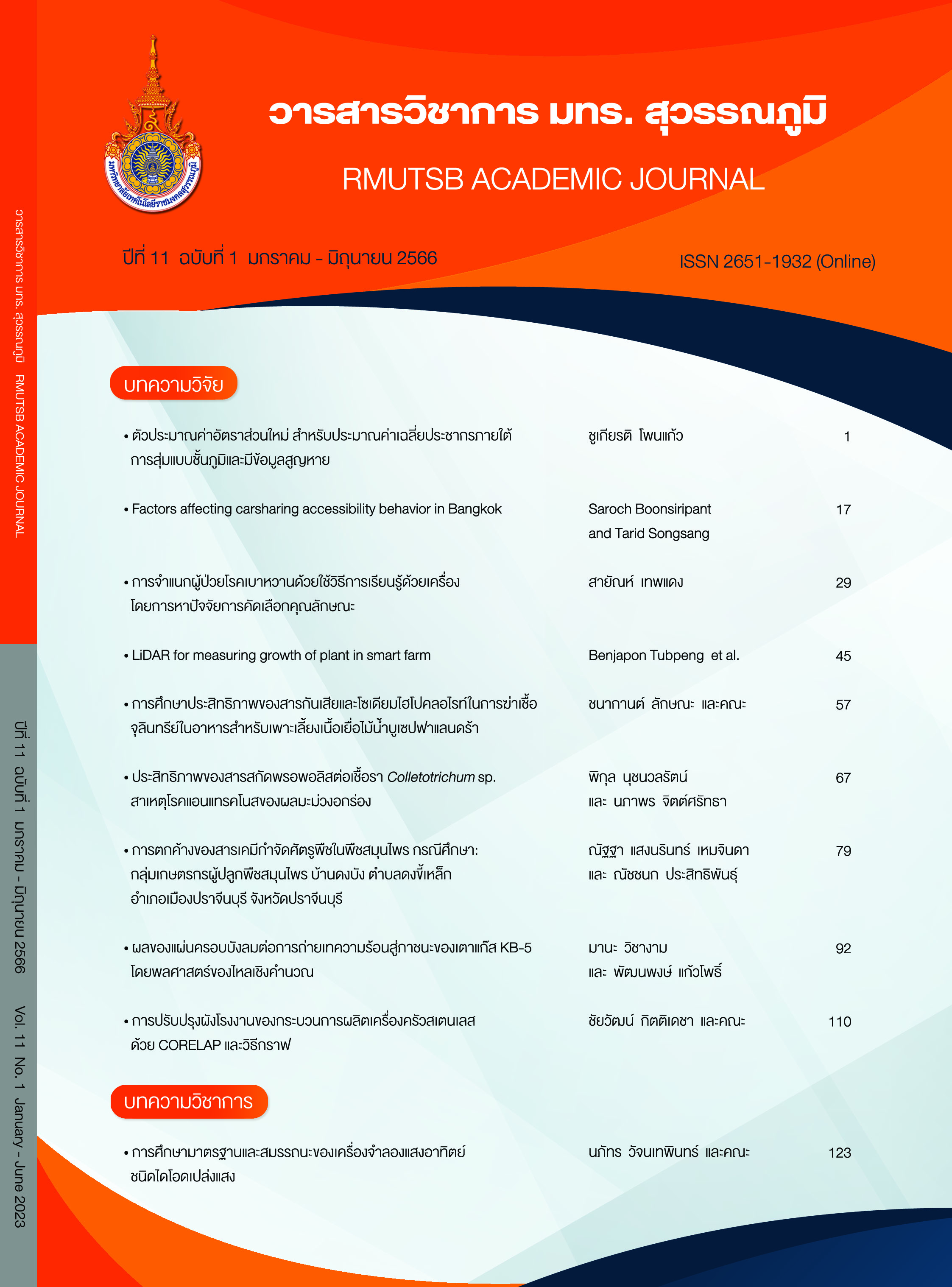Effect of wind shield on heat transfer to pot of KB-5 cooking stove by computational fluid dynamics
Main Article Content
Abstract
The objective of this research was to study effect of wind shield on heat transfer to pot of KB-5 cooking stove by computational fluid dynamics and experiment. The simulation model was created by ANSYS 21. Heat transfer to pot of stove with wind shield being, model B (cylindrical wind shield), model C (inverted cone wind shield) and model D (upturned cone wind shield) were compared with KB-5 original stove model A (without wind shield). Analyze the thermal efficiency and heat transfer to pot on total heat flux was conducted. The results showed that model C is inverted cone wind shield allows the flame to flow together in the center of the combustion chamber before flowing to pot, thus causing model C had the highest thermal efficiency and total heat flux. model C had the highest thermal efficiency of 46.18%, followed by model B, model D and model A with thermal efficiency of 43.62, 41.52 and 39.15%, respectively, or model C increased in thermal efficiency by 5.54, 10.09 and 15.22% compared to model B, model D and model A, respectively. model C had the highest total heat flux of 24.73 kW/m2, followed by model B, model D and model A with thermal efficiency of 22.18, 20.96 and 18.32 kW/m2, respectively, or model C had total heat flux increase of 10.31, 15.24 and 25.93% compared to model B, model D and model A, respectively.
Article Details

This work is licensed under a Creative Commons Attribution-NonCommercial-NoDerivatives 4.0 International License.
Published manuscript are the rights of their original owners and RMUTSB Academic Journal. The manuscript content belongs to the authors' idea, it is not the opinion of the journal's committee and not the responsibility of Rajamangala University of Technology Suvarnabhumi
References
ANSYS. (2013). Ansys fluent theory guide. Canonsburg, Pennsylvania: ANSYS.
Aroonjarattham, P. (2015). The parametric studied of high pressure gas burner affect thermal efficiency. Engineering Journal, 20(3), 33-48.
Boggavarapu, P., Ray, B., & Ravikrishna, R. V. (2014). Thermal efficiency of LPG and PNG-fired burners: Experimental and numerical studies. Fuel, 116 (2014), 709-175.
German Standards and Technical Rules. (1997). DIN EN 203-2: Gas-heated catering equipment. German technical standard.
Jenjit, J. (2010). Thermal efficiency improvement at household cooking burner by porous radiant recalculated cover (Master’s thesis). Ubon Ratchathani University, Ubon Ratchathani.
Khongsanthear, V., & Krittacom, B. (2012). Domestic gas stove using combined porous material. Proceeding of ME-NETT 26th Conferences (AEC 2058). Bangkok: King Mongkut’s University of Technology Thonburi.
Matthujak, A., Wichangarm, M., Sriveerakul, T., Sucharitpwatskul, S., & Phongthanapanich, S. (2021). Numerical investigation on the influences of swirling flow to thermal efficiency enhancement of an LPG-energy saving burner. Case Studies in Thermal Engineering, 28(2021), 101466.
Matthujak, A., Chanakul, T., Wichangarm, M., Sriveerakul, T., Chanthamas, B., Sucharitpwatskul, S., & Phongthanapanich, S. (2020). A study on influence of swirl angle of burner port on behavior of heat transfer to a vessel of high-pressure cooking stove by computational fluid dynamics. RMUTP Research Journal, 14(1), 70-81.
Tamir, A., Elperin, I., & Yotzerx, S. (1988). Performance characteristics of a gas burner with a swirling central flame. Energy, 14(7), 373-382.
Tawonwan, T., & Wansao, C. (2016). A study of behavior of the air flow through circular cylinder rows in the low speed wind tunnel with computational fluid dynamics technique. RMUTSB Academic Journal, 4(1), 32-45.
Wae-hayee, M., Yeranee, K., Suksuwan, W., & Nuntadusit, C. (2021). Effect of burner-to-plate distance on heat transfer rate in a domestic stove using LPG. Case Studies in Thermal Engineering, 28(2021), 101418.
Wichangarm, M., & Matthujak, A. (2022). Simulation on flow behavior KB-5 burner using computational fluid dynamics. Proceeding of the 5th National Conference on Science, Technology and Innovation: Technology, Creative Innovation and Entrepreneurship (pp. 357-364). Bangkok: Rajamangala University of Technology Phra Nakhon.
Wichangarm, M., Matthujak, A., Sriveerakul, T., Sucharitpwatskul, S., & Phongthanapanich, S. (2020). Investigation on thermal efficiency of LPG cooking burner using computational fluid dynamics. Energy, 203(2020), 117849.
Wichangarm, M., Matthujak, A., Sriveerakul, T., Sucharitpwatskul, S., & Phongthanapanich, S. (2019). A study on effect of swirling flow on behavior of heat transfer to vessel of high pressure cooking stove by computational fluid dynamics. Proceeding of ME-NETT 33rd Conferences (AEC003). Mahasarakham: Mahasarakham University.
Wichangarm, M., Matthujak, A., Sriveerakul, T., Sucharitpwatskul, S., & Phongthanapanich, S. (2018). Simulation study of LPG cooking burner. International Journal of Engineering & Technology, 7(3.7), 142-144.
Wichangarm, M., Matthujak, A., Sriveerakul, T., & Sucharitpwatskul, S. (2016). Simulation of flow characteristics in an energy-saving high-pressure gas stove. Proceeding of ME-NETT 30th Conferences (CST0027). Songkhla: Prince of Songkla University.


